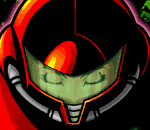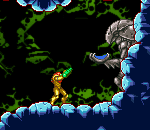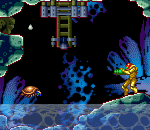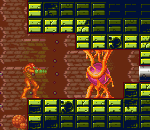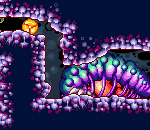Data
Guides and strategies
- Power-up locations
- Shinespark Guide
- Bosses Guide
- Obstacles Guide
- Walkthrough
- Game endings
- Secrets and tips
- Game maps
Media
Metroid: Zero Mission review
![]() Not many gaming series can claim that most (if not every) title under their wing has golden gameplay, superb graphics and award-winning audio. The Metroid series is certainly one that hasn't failed to deliver, which is demonstrated flawlessly in Metroid: Zero Mission. Based loosely on the original NES Metroid, Zero Mission broadens the story of bounty hunter Samus Aran's first mission, and it couldn't have been better.
Not many gaming series can claim that most (if not every) title under their wing has golden gameplay, superb graphics and award-winning audio. The Metroid series is certainly one that hasn't failed to deliver, which is demonstrated flawlessly in Metroid: Zero Mission. Based loosely on the original NES Metroid, Zero Mission broadens the story of bounty hunter Samus Aran's first mission, and it couldn't have been better.
My own first outing in the Metroid universe began with Super Metroid, but I can certainly see why fans of the original would love and cherish everything from this installment. Take the original NES game, mix in a variation of Super Metroid's graphical stye and Metroid Fusion's gameplay then bake till golden brown. This is your juicy and delicious result. Everything from the original Metroid's here, and you'll be plunged head first into the game's many elements paying homage to the first game - even the title theme's a remake of the original.
Without giving anything away about the actual story (which has been drastically extended from the original), this game redefines the word remake. It feels more like a true Metroid game on its own. It may not continue the story after the events of Metroid Fusion, but deserves a perfect score for keeping the Metroid elements alive and well. But let me say this, the game begins exactly the way the original did, only don't expect a quick climax after defeating Mother Brain. You should play the game to find out what happens, but Nintendo have done a great job in furthering the story and it completely does away with the "just a remake" idea. There's a lot more to Samus' first encounter with the Metroids than we once thought.
Let's begin by asking the first critical question, "does this game deliver?" The answer is a resounding yes, and you'll see why modern 3D games will never do away with good old 2D platforming fun.
![]() Gameplay is probably the most critical element of the game to tie it into the Metroid world. Long-time Metroid fans and experts won't even need to read the manual, as all the gameplay elements from Super Metroid and Metroid Fusion are back in full force. The basic controls are almost identical to Fusion's, so directing Samus around is never an issue - the programmers really know how to give players total control. Running, jumping, using the Morph Ball and switching between weapons is a breeze, at some points the game may seem to be a tad too easy, but that's what the newly featured difficulty modes are for.
Gameplay is probably the most critical element of the game to tie it into the Metroid world. Long-time Metroid fans and experts won't even need to read the manual, as all the gameplay elements from Super Metroid and Metroid Fusion are back in full force. The basic controls are almost identical to Fusion's, so directing Samus around is never an issue - the programmers really know how to give players total control. Running, jumping, using the Morph Ball and switching between weapons is a breeze, at some points the game may seem to be a tad too easy, but that's what the newly featured difficulty modes are for.
All the classic platform elements are here, so mastering Samus is no difficult task. A few new gameplay elements from Fusion have also returned. Samus' ability to grab hold of platforms is back (which opens up a new can of worms on its own) and some brand new elements such as... hang on, I'd better stop now before giving anything away - but rest assured you'll love what's waiting.
Another famous element of the Metroid games - the graphics - have always been industry-leading standards. The game pays complete homage to the classics in the graphics department, from small subtleties like Samus always holding out her arm cannon forward like she did in the NES Metroid and the 32-bit graphical environments and sprites rivaling those seen in Super Metroid. You really need to play this game on a GBA SP, Game Boy Player or Nintendo DS to fully enjoy the gorgeous detail ever-present on the screen - the original GBA's screen won't do it justice. It looks like the artist department and graphics development team at Nintendo's R&D1 have poured their hearts into the visuals. Thankfully their efforts have paid off.
![]() Even though many elements of the graphics engine were based on Fusion's, this game has a much more Metroid-ish feel to it - Zebes has been perfectly recreated. They've also nailed the spriting animation, the detail in Samus' movements and enemies is perfect (I love the way her arm cannon opens up when firing a missile). Another new addition to this game is the inclusion of short cinematics - these really bring the action and storyline to life, especially when there's no spoken dialogue unlike Samus' dealings with her ship's computer in Fusion. All the sprites, environments and backdrops come together perfectly to produce a richly detailed Metroid-authentic world. Thanks to the GBA's capabilities there's never any slowdown, so it's fair game when taking on those massive bosses.
Even though many elements of the graphics engine were based on Fusion's, this game has a much more Metroid-ish feel to it - Zebes has been perfectly recreated. They've also nailed the spriting animation, the detail in Samus' movements and enemies is perfect (I love the way her arm cannon opens up when firing a missile). Another new addition to this game is the inclusion of short cinematics - these really bring the action and storyline to life, especially when there's no spoken dialogue unlike Samus' dealings with her ship's computer in Fusion. All the sprites, environments and backdrops come together perfectly to produce a richly detailed Metroid-authentic world. Thanks to the GBA's capabilities there's never any slowdown, so it's fair game when taking on those massive bosses.
Kenji Yamamoto is a man of many talents. He creates true audio masterpieces, bringing the Metroid games to life and whisking you away to join Samus in her adventures. After producing superb musical scores for Metroid Prime and Metroid Fusion, he's back providing stunning musical themes based on Hip Tanaka's original Metroid tunes. Upon entering a new area of Zebes, Metroid fans will instantly recognise the old themes re-mixed for today's standards. You might find the music not as atmospherically creepy or eerie as Super Metroid's soundtrack, but it still suits the game and fits perfectly with the twisting enviroments of Zebes.
![]() The sound effects are also top-notch, with a few you'll recognise as reused from Fusion. Don't feel too overwhelmed by the re-mixed themes as there are a bunch of new themes built specifically for newer areas you'll be exploring, and you'll be humming these great themes to yourself for days after playing it for a few hours. The effects are all richly detailed and further enhance the Metroid-authenticity - when you're outside in the pouring rain and hear rumbling thunder in the distance (in the game) you'll know what I mean.
The sound effects are also top-notch, with a few you'll recognise as reused from Fusion. Don't feel too overwhelmed by the re-mixed themes as there are a bunch of new themes built specifically for newer areas you'll be exploring, and you'll be humming these great themes to yourself for days after playing it for a few hours. The effects are all richly detailed and further enhance the Metroid-authenticity - when you're outside in the pouring rain and hear rumbling thunder in the distance (in the game) you'll know what I mean.
The Metroid series has redefined the meaning of the word fun. The perfect combination of elements including exploration, gameplay, graphics and sound is responsible for this. But one other crucial factor is the replay value and lastibility. Don't expect to fully finish the game on your first try in under 6 hours, as despite basing the maps on the NES Metroid, most item locations have been completely moved around and scattered throughout the mazes. Besides, this game has all the added upgrades and items not originally featured in the first game like the Space Jump and Power Bombs, so there's plenty of treasure hunting to be had here.
The addition of difficulty modes (first used in the Japanese version of Fusion) also adds extra replay value, as do the multiple endings which as a bonus you can record in an image gallery and check out whenever you want. If you take anything away from this let it be thus, remember that this is a Metroid game, and all Metroid games have that special element (whether it be exploration or sequence breaking) which allows you come back to a game you've beaten over and over and yet still have a great time.
![]() In some ways it's just a remake of the original, in others it's a completely innovative and golden new Metroid experience - it all depends on your point of view. But Metroid: Zero Mission delivers on all fronts: great graphics, great sound, great gameplay. If you're a long-time Metroid fan and treasure all those moments long ago when you first explored the 8-bit mazes of Zebes, do yourself a favour and discover why Nintendo keep 2D gaming alive.
In some ways it's just a remake of the original, in others it's a completely innovative and golden new Metroid experience - it all depends on your point of view. But Metroid: Zero Mission delivers on all fronts: great graphics, great sound, great gameplay. If you're a long-time Metroid fan and treasure all those moments long ago when you first explored the 8-bit mazes of Zebes, do yourself a favour and discover why Nintendo keep 2D gaming alive.
This is Metroid at its finest and wholly original 2D glory. Keep an open mind on the whole remake concept and you won't be disappointed. Nintendo made us wait eight long years for a fourth Metroid game, but with three new ones over the space of just 15 months (at the time of Zero Mission's release) I think they've more than made up for it.
Written by Falcon Zero on 1 January 2010.













